Spotted knapweed (Centaurea stoebe ssp. micranthos) is a grassland perennial plant native to Eurasia. It was first recorded in North America in 1893 and in Minnesota in 1918, likely introduced as a contaminant of alfalfa seed. Spotted knapweed is able to outcompete other plants by exuding a toxic chemical from its roots. This allows it to establish and spread quickly to colonize vast acreages. Infestations decrease forage, wildlife habitat, plant diversity and recreational quality yet increase soil erosion.
Biological control with a combination of seedhead and root weevils has been cost-effective and successful at greatly reducing infestations at sites that are undisturbed. The use of weevils to control spotted knapweed continues to be a collaborative effort with public and private land managers, County Agricultural Inspectors and the Minnesota Department of Agriculture.
Since spotted knapweed is native to Eurasia, it lacks the insects and diseases in North America that keep it in check in its native range. Biological control reunites the target plant with its natural insect and disease controls. The bioagents used for controlling spotted knapweed were tested extensively to ensure that they will feed only on the target weeds.
Seedhead weevils, Larinus minutus and L. obtusus
Seedhead weevils lay their eggs knapweed flowers and the larvae consume the developing spotted knapweed seed. Adult seedhead weevils overwinter in the plant litter on the ground at the base of spotted knapweed plants. In the late spring and early summer, adults emerge to feed on the foliage, mate and lay their eggs in the knapweed flowerhead. The eggs hatch in three days and the larvae consume the material in the seedhead for about four weeks. Then the adults pupate and emerge to feed on foliage before burrowing in their overwintering sites.
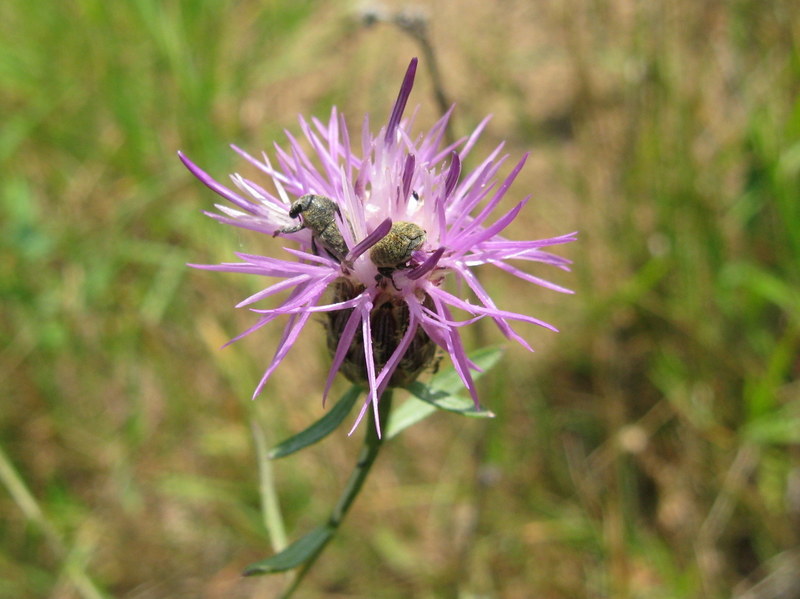 |
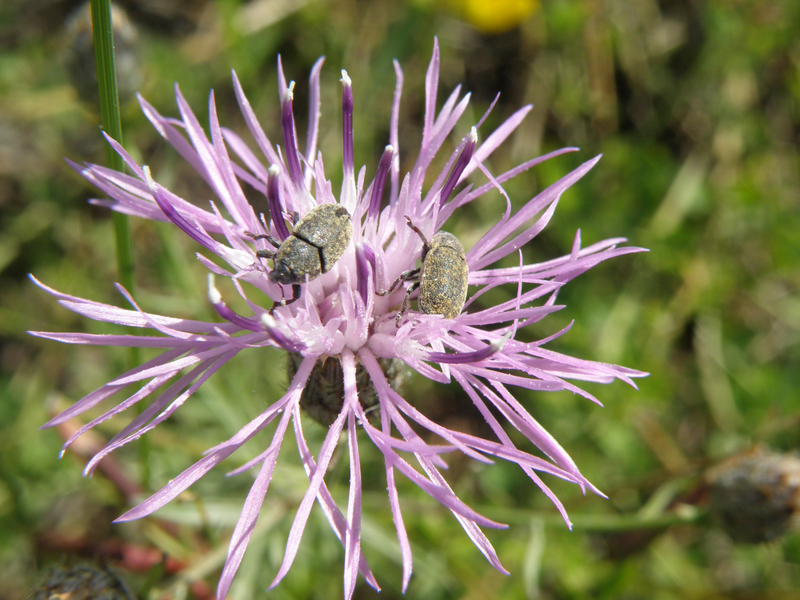 |
Root boring weevils, Cyphocleonus achates
Root boring weevils are highly effective biological control agents because they weaken or kill existing knapweed plants. From mid summer through early fall, adult females lay eggs on the soil surface at the base of knapweed plants. After hatching, the larvae burrow into the roots where they feed and develop over the winter, spring, and early summer. The developing larvae in the roots use precious plant resources and damage the roots. As a result, the plant is weakened or killed. Adults will emerge from the damaged roots in the mid to late summer to feed on the foliage, mate, and start the cycle again.
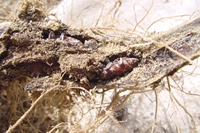 |
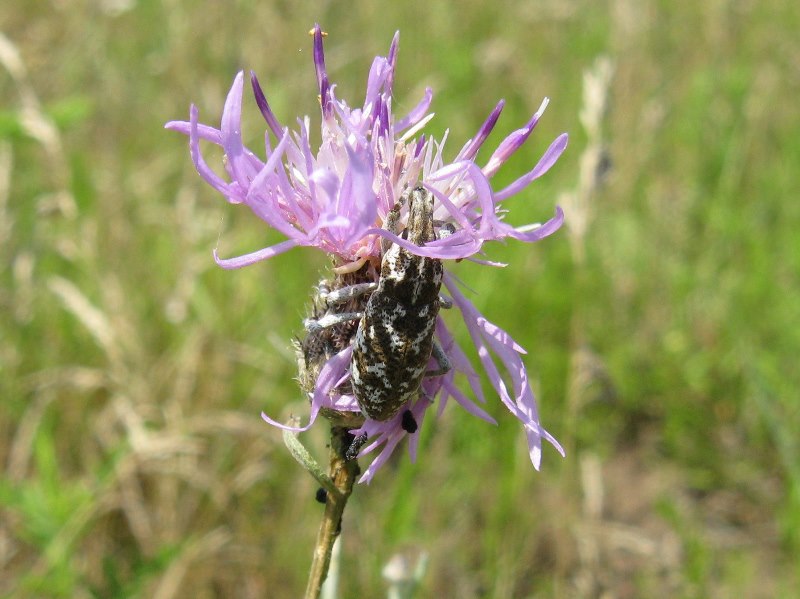 |
Starting and maintaining a spotted knapweed biological control program
1. Assess the site.
How much spotted knapweed do you have? Is it one large continuous patch or several smaller, isolated patches? An infestation should be approximately an acre or larger. If you have only a few plants, you should consider hand pulling (use gloves and wear protective clothing) or spraying the plants with a herbicide and follow up over the next three to four years.
Disturbed sites such as active gravel pits and mowed roadsides are not appropriate for biocontrol. Do not select sites that will be mowed.
2. Obtain weevils.
Call your County Agricultural Inspector (CAI) or the MDA and explain that you have spotted knapweed on your land and are interested in using biocontrol. The CAIs have a well-established network that coordinates with multiple agencies, including the MDA, to ensure that spotted knapweed weevils are distributed where needed. Seedhead weevils are widely distributed in Minnesota so they are only released at sites where they are not already present. Root weevils are collected and distributed July – early September.
There is no charge or cost to the landowner for the weevils.
3. Release the weevils. Releasing them is simple.
Take a photo of the site so you have an image to compare with several years following the weevil release.
Make a note of the release location or mark the spot with a stake.
Open the container of weevils and gently pour them onto the spotted knapweed plants. The weevils will disperse. Do not worry about touching the weevils. They will not harm you.
4. It is important to monitor the site over the next few years to determine progress.
It is unlikely that you will see immediate changes.
The third summer after release, go back to the release site and look for weevils. Seedhead weevils are on knapweed flowers in July. Root weevils hang onto knapweed flowerheads below the petals July through September. Root weevils are masters of camouflage and difficult to find so don't be discouraged if you don't see any.
Years after release, you may begin to see a decrease in the amount of spotted knapweed although you are unlikely to see foliar damage. Again check for weevils. If at this point you don't find any weevils and see no decrease in the amount of spotted knapweed, call your CAI or the MDA for advice.
If you see spotted knapweed beginning to decrease, call your CAI or the MDA to report the progress. It is possible that your site has a collectible population of biocontrol agents. Weevils can be collected and moved to a new location.
Do not worry about depleting the spotted knapweed weevil population. Many will remain after the collection and will continue to eat away at the spotted knapweed.
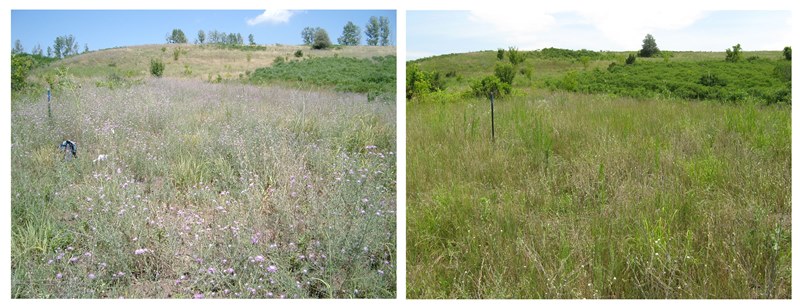
A combination of seedhead and root weevils greatly reduced the spotted knapweed infestation pictured on the left.
Collecting and moving spotted knapweed weevils
The weevils are collected into plastic bottles then transferred to paper containers with some knapweed. If the containers cannot be handed directly to the land manager, the containers can be express shipped to a land manager who releases the weevils. The goal is to release the weevils quickly after collecting them to ensure the weevils are healthy.
Other insect biocontrol agents
Some other bioagents were released in Minnesota and other states. These include seedhead flies (Urophora affinis and U. quadrifasciata) and a root-boring moth (Agapeta zoegana). They are not usually distributed because seedhead flies are widespread throughout the state already and the root-boring moth is difficult to collect. Also, the seedhead and root weevils are generally very effective at controlling spotted knapweed without additional species. However, you may observe these species in spotted knapweed infestations.
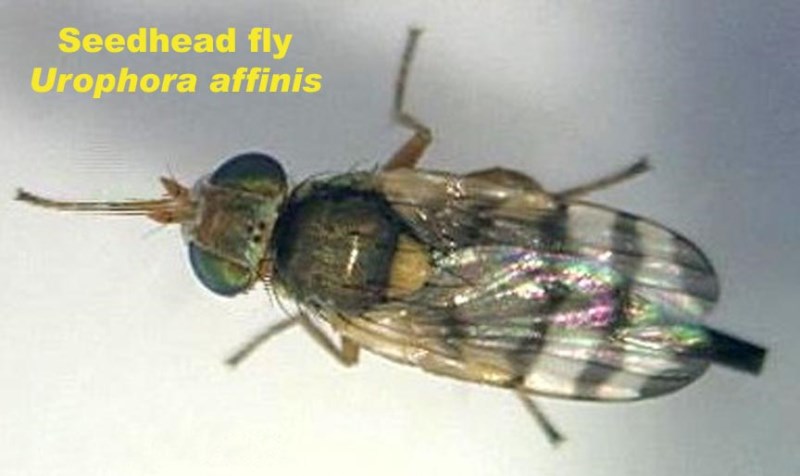 |
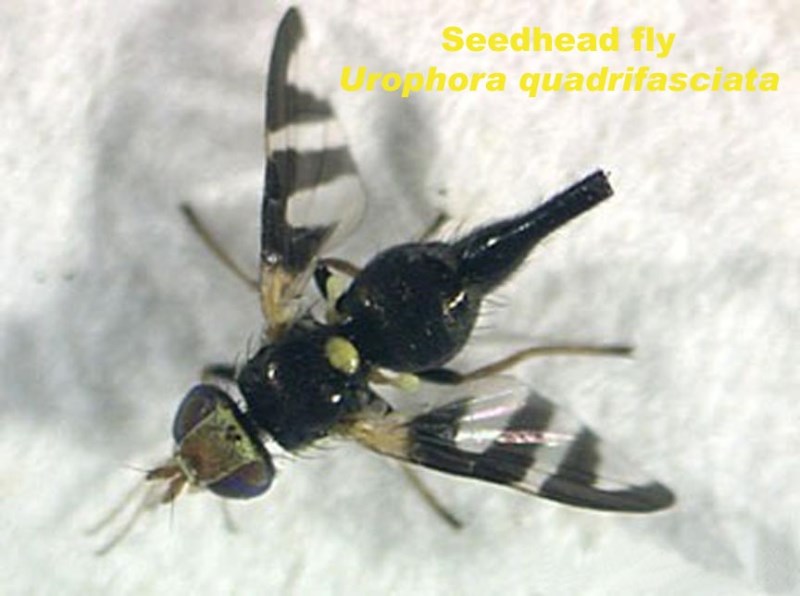 |
Goats and sheep
Goats and sheep can control spotted knapweed in pastures when the right techniques are used.
Integrating control methods
- Hand-pulling and digging can be used to control small patches of spotted knapweed. Use gloves and protective clothing when handling the plants.
- Herbicides can be used to control small patches escaping from a large infestation to prevent the infestation from spreading while the weevils do their work. Contact your local extension agent for herbicide recommendations.
- Burning can be used to increase native plant competition in natural areas. Burning should not be done while the adult forms of the weevils are present (June-September).
County Agricultural Inspector contacts
For more information:
Biology and Biological Control of Knapweed (PDF) - U.S. Forest Service

